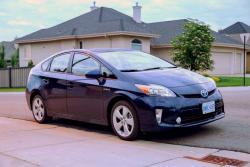 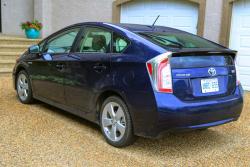 2013 Toyota Prius. Click image to enlarge |
Review and photos by Tom Sedens
Though the Toyota Prius is no longer a lone ranger on the hybrid frontier, it still tends to be the first one to come to mind for me. Because it blazed these heretofore unknown trails, it forged paths where there were none, and carved out a niche that didn’t exist before.
The real story is and always has been the now-familiar 1.8L four-cylinder hybrid drivetrain, putting out 134 horsepower. As is typical, no torque rating is supplied for this hybrid. The power comes from the gas engine feeding a CVT (continuously variable transmission), as well as an electric motor – all driving the front wheels.
Of course, the point of this exercise is two-fold: to use as little fuel as possible, thereby saving the environment and, in theory, your money (at some point in time, once you earn back the extra you spent on a hybrid). Fuel economy ratings are 3.7 L/100 km in the city and 4.0 L/100 km on the highway. During my week with it, driving normally (mostly slower commuting, minor freeway travel and one highway drive) with no effort to save gas, I averaged an almost unbelievable 5.0 L/100 km.
The Prius has a 45 L tank and weighs 1,380 kg (3,042 lb).
The shape has evolved very slightly from the original, with little details here and there. But it’s basically still the same five-door liftback wedge design that leaves many people out in the cold. And why on earth would Toyota mess with what has now become the most recognizable, iconic hybrid on the market?
It’s not pretty, to be sure, but regular readers will likely not be surprised when I say this: I don’t mind it. I love a wagon/van shape and I love when functionality beats out fashion on occasion.
    2013 Toyota Prius. Click image to enlarge |
The Touring package gives this one some nifty LED headlights, and some nicely integrated fog lights below. Though there are mild hints of aggression in the swept-back headlight pods and in the lower air dam, nobody will mistake this for a car that means business. Toyota has added some details to give the taillights some interest as well.
The 17-inch wheels look quite good (especially versus the wheel covers you see on some Priuses), and wear 215/45-sized tires.
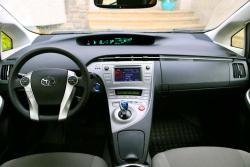 2013 Toyota Prius. Click image to enlarge |
Inside, you’ll find unique styling again. The dash consists of a simple swoosh all the way across, lifting in the middle for a raised eyebrow over some digital information screens that replace the gauges. The materials are hard plastic throughout and although Toyota has attempted to bring some organic textures to the table, the effect is still “economy car”. Though the fit and finish is good, nothing feels premium, including the mouse-fur trim on the door panels, pillars and roof, and the seat fabrics. In addition, the blandness continues with the 50 Shades of Grey theme they’ve chosen. It’s not nearly as exciting as you might think.
The Prius feels roomy inside, and provides good headroom for my 5’10” size.
Ahead of you is a manually adjustable steering wheel with control pads and buttons. They handle temperature, the driver information screen, the media system, hands-free and phone functions.
That eyebrow bin I mentioned has two sides. On the left is a digital speedo, an instant mileage gauge and the gear selector position. The right side is the driver information screen that lets you cycle through a graphic display of where your energy is coming from, a digital version of the charge/eco/power flow for which many hybrids use a traditional gauge, and a few screens relating to fuel economy.
The manually adjustable fabric seats are actually quite comfortable and are surprisingly well bolstered for a car that doesn’t even pretend to be sporty.
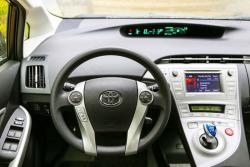 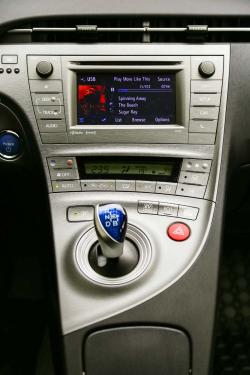 2013 Toyota Prius. Click image to enlarge |
There isn’t so much of a centre stack as a floating console. It starts with a 6.1-inch touchscreen at the top. Hard buttons for accessing the major functions surround the screen. The media system feeds off AM, FM, satellite radio, USB, auxiliary and Bluetooth streaming sources and it sounds decent. The screen also handles the navigation system and the back-up camera. I found it irritating that there are no distance markings for the camera, nor parking distance sensors.
Below the screen is the automatic climate control system.
As the console becomes horizontal and slants down toward the rear, you’ll find the Prius’s unique joystick-style gear knob and “Park” button combo. Alongside it, you’ll also see some drive mode buttons, two cupholders and an armrest at the back.
Entry is keyless, there’s push-start ignition, automatic headlights and an integrated universal garage door opener.
I found the rear seating area quite spacious, and headroom is good for my frame. Leg and foot room are quite roomy as well. There are three seats, each with a headrest and a seatbelt. The two outboard seats are comfortable. The middle seating position is pretty narrow, but will accommodate an adult if necessary.
It’s pretty spartan back there – you get two seatback map pockets and that’s about it. No door bins, no charging plugs. The middle seatback folds down to become an armrest with two cupholders.
There are two sets of LATCH connectors. We got our three kids back there, but it was a bit squished (with their seats/boosters) in terms of width.
Cabin storage is acceptable. There are little door bins, upper and lower glove compartments – both a good size – and a reasonable compartment under the armrest lid.
There’s a great open carpeted storage area under the floating center console. It’s a bit tough to get to, but it’s accessible from both sides and is good for throwing a bunch of stuff into.
The Prius offers fantastic utility in the trunk. The space behind the rear seats is 612 L and is easily accessible and very useable. With the rear seats folded (they split 60/40 and go relatively flat), you can add significant cargo volume, but Toyota doesn’t say how much of it. There’s also plenty of underfloor storage, a cargo net and four heavy-duty tie-down hooks and you can cover the whole thing with a retractable, removable tonneau cover.
    2013 Toyota Prius. Click image to enlarge |
You shouldn’t be surprised to find that the Prius feels sluggish in normal driving. Acceleration is very smooth and linear, and you don’t notice the engine starting or stopping. But as seamless as it is, it always feels a bit gutless and it feels as though you’re fighting the car for a little more power. Get up to speed though, and it cruises happily – even at highway speeds. I did find the power sorely lacking when it came to passing on the freeway. Leave yourself ample time and space for this kind of thing, as the Prius does not comply quickly. You’ll certainly see more performance from the Ford C-Max, but you’re also not likely to achieve the same kind of fuel economy with Ford’s hybrid.
There are three drive modes. EV (electric vehicle) mode uses purely electric power with a range of up to 1.6 kilometres. It’s more or less an experiment in how lightly you can feather the throttle, and might be useful for neighborhoods with a lot of old people and small children in them. There’s also an Eco mode. Eco modes are pretty common these days. They retard a car’s throttle response and do what they can to save fuel. As I’ve already noted, the Prius isn’t a real drag-strip champ and pretty much feels like a normal car in Eco mode all the time. Turn on Eco mode in the Prius and it dampens the already soggy spirit to save even more fuel. I found it almost undriveable. And finally there’s Power mode. It enhances acceleration and actually makes it feel almost like a normal car in terms of moving off the line. Of course, in order to do that, it’s using more of the electric motor’s torque and therefore saps your battery quicker.
The ride is firm but quite well done. I found that it soaks up most of the hits nicely, and only got crashy on rare occasions over some nasty road irregularities. I was surprised to find good handling in the Prius. It has decent road-holding capabilities, and although the car always feels heavy, I found it easy to thread through daily traffic and to throw it into curves. Toyota brings its lifeless steering to the game of course, so don’t expect any kind of feedback or anything of the like.
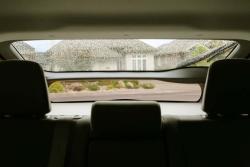 2013 Toyota Prius. Click image to enlarge |
Visibility out of the car is pretty good, except out the back. The rear view is horribly bisected by the bar between the horizontal and vertical parts of the trunk lid, and it drove me nuts every single time I looked in the mirror.
The Prius is quiet. Off the line, if you’re not using heavy throttle, it will stay in EV mode and run almost silently with a little hint of Darth Vader drone. You barely ever hear the engine unless you really step on it and it has to rev up – in that case, it makes some awful sounds. Wind noise is very well controlled thanks to the slippery shape but road noise occasionally creeps into the cabin.
The brakes are typical hybrid – powerful but grabby since they are using regenerative technology to charge the batteries while you’re braking.
I didn’t mind the Prius at all. Its mission is obviously to be a fuel economy champion, and it succeeds mightily here. To achieve the 5.0 I did while driving the way I did is almost difficult to process. Yes, it’s a relatively slow car. But it’s easy to drive, it handles well and its road manners are refined. On top of that, it offers plenty of space for four adults and their luggage, or lets you transport a ton of stuff with the rear seats down.
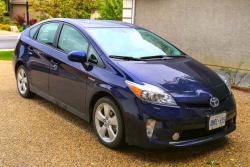 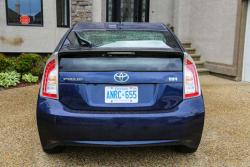 2013 Toyota Prius. Click image to enlarge |
I appreciate that the Prius is honest. There’s nothing on paper that makes you think you’ll get anything different, and if you’re after a vehicle that will get astounding fuel economy, be a decent car to drive on a daily basis and retain stellar resale value, there’s no reason you shouldn’t consider the Prius.
WAF (Wife Acceptance Factor) was decent. She liked how smooth the driving experience was, but felt it was underpowered. She wasn’t fond of the exterior styling but said she got used to the interior, and the fact that the trunk could swallow an entire day’s worth of shopping made up for the ugliness.
It’s not an exciting car, to be sure, but it’s exciting to see what can be achieved in terms of fuel economy for a car this size. If fuel economy matters more than anything else, and you want simple practicality, the Prius is still the king of the hill.
|
Related Articles: Manufacturer’s Website: Photo Gallery: |
Pricing: 2013 Toyota Prius
Base price: $26,100
Options: Touring Package – $3,555; Block heater – $259.95
Freight: $1,620
A/C tax: $100
Price as tested: $31,634.95
Competitors:
Ford C-Max
Honda Insight
Volkswagen Jetta Hybrid
Volkswagen Jetta TDI
Crash Test Results:
National Highway Traffic Safety Administration (NHTSA)
Insurance Institute for Highway Safety (IIHS)











